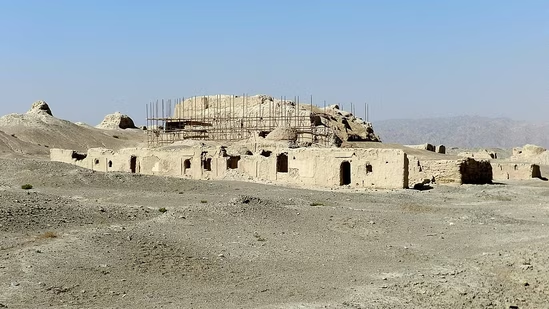China is using archaeology as a weapon
In the desert outside Kashgar, an oasis city in the far-western region of Xinjiang, an ancient Buddhist stupa rises out of the sand. Because of its conical shape, it is known as Mo’er, the word for “chimney” in the language of the native Uyghurs. The stupa and the temple next to it were probably built some 1,700 years ago and abandoned a few centuries later. Chinese archaeologists started excavating the site in 2019. They have dug up stone tools, copper coins and fragments of a Buddha statue.

They also claim to have found clear proof that Xinjiang has been part of China since ancient times. According to official statements, artefacts discovered at Mo’er temple are similar to those dug up thousands of miles to the east in areas dominated by the Han, China’s majority ethnic group. Parts of the temple were built in a “Han Buddhist” style. And its architectural features suggest that it was visited by a famous 7th-century monk from central China called Xuanzang. He is known for spreading Buddhism in the country.
These claims may sound academic, but China’s government is using them to justify its brutal rule over Xinjiang. At the peak of a security campaign in 2018-19, perhaps a million Uyghurs and other Muslim residents of Xinjiang passed through camps where they were forcibly assimilated into Han Chinese culture. Critics accuse China of cultural genocide. Officials say they are trying to stamp out religious extremism. Moreover, if the inhabitants of Xinjiang have always been Chinese, then accusations of forced assimilation make no sense.
Last month China organised a conference in Kashgar that focused on the discoveries made at Mo’er temple and other sites. They prove that there is no separation between the culture of Xinjiang and Chinese culture, said Pan Yue, head of the state’s Ethnic Affairs Commission. Those who criticise China’s policies in the region reveal their “ignorance of history” and are peddling “baseless narratives”, he added.
In fact, it is China’s narrative that looks dodgy, say experts. The country’s ancient dynasties had an on-and-off military foothold in what is now Xinjiang, says James Millward of Georgetown University. But from the 8th century to the early 18th century, they had little influence. Then in 1759 China’s final dynasty, the Qing, conquered the region and turned it into a colony. That is what the Communist Party inherited when it came to power in 1949.
Sites like Mo’er temple are fascinating, but do little to strengthen China’s claims. They demonstrate the globalising effect of the Silk Road, a network of trade routes that linked China with Central Asia and Europe. Just as money and commodities flowed along the road, so did religions such as Buddhism, picking up aspects of local cultures along the way. Many of the Uyghurs’ ancestors were indeed Buddhist. But that hardly means Xinjiang was culturally or politically part of China. After all, Buddhism originally came from India.
In any case, since the 16th century most Uyghurs have practised Islam. But China has no interest in this later period. Instead, officials are trying to erase it. In recent years they have destroyed hundreds of mosques and Muslim shrines across Xinjiang. The museum in Kashgar barely mentions Islam, save for signs claiming that it was forced on Xinjiang and that the Uyghurs “are not Muslim by nature”.
When your correspondent visited Mo’er temple this month, it was being turned into a tourist site. The ruins are surrounded by buildings with sloping roof tiles and red doors, mimicking those of Beijing’s Forbidden City. The style is appropriate, said a Han construction worker. Buddhist culture is part of Han culture, he claimed, and Xinjiang has been part of China for thousands of years.
Subscribers can sign up to Drum Tower, our new weekly newsletter, to understand what the world makes of China—and what China makes of the world.
© 2023, The Economist Newspaper Limited. All rights reserved. From The Economist, published under licence. The original content can be found on www.economist.com
Disclaimer: The copyright of this article belongs to the original author. Reposting this article is solely for the purpose of information dissemination and does not constitute any investment advice. If there is any infringement, please contact us immediately. We will make corrections or deletions as necessary. Thank you.
Title:China is using archaeology as a weapon
Url:https://www.investsfocus.com



